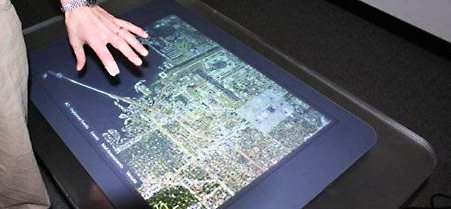Portal key to Tampa's Super Bowl preparations
Web site allowed city police, fire and emergency medical personnel, as well as state and federal agents, to plan for traffic snarls, accidents and possible attacks.
 This touchscreen mapping display allows law enforcement to zoom in on locations to see and respond to real-time activities. (
Microsoft
)
This touchscreen mapping display allows law enforcement to zoom in on locations to see and respond to real-time activities. (
Microsoft
)
Information technology played a key role in coordinating the efforts of local, state and federal agencies that relied on an everyday Web portal to streamline communications and to share information to plan this week's Super Bowl, said a Tampa law enforcement official.
"Anybody can do a smother effect -- bring 10,000 troops in and make a shoulder-to-shoulder defense strategy that's extremely inefficient," said Maj. John Bennett, Tampa incident commander for the Super Bowl. "But we're not as resource-rich as some Super Bowl cities. We had to be strategic and use technology to best manage our assets during the planning phase as well as now."
Kickoff for the National Football League championship game is not scheduled until Sunday evening, but planning for the event began two years ago, said Bennett, whose regular job is commander of the special operations division in the Tampa Police Department in Florida. Planning for Super Bowl XLIII began when a group of the city's law enforcement agents attended the Super Bowls in Phoenix, Ariz., in 2008 and Miami in 2007, as part of what Bennett called the "demystification phase." They took photos of the locations and notes about the surrounding environments and how the local law enforcement agencies managed the events.
The Tampa officers then used a Web portal, based on Microsoft's SharePoint software, to distribute their observations and findings with hundreds of city officials who were involved in the planning of this year's Super Bowl. The city gave state and federal authorities access to the site to integrate communications from the initial planning of the Super Bowl through execution. The site can be accessed from a variety of hardware devices, including desktops and laptops, and handheld devices.
"What we're seeing not only in this opportunity, but across public sector, is a drive to streamline communication and collaboration," said Josh Rice, director of the incubation team in Microsoft's public sector group. "If it's a one-time situation like this, or even a day-to-day operation, there needs to be a way to make it easier to share information and communicate with tools that [agencies] are already using. For the [Super Bowl], they needed a visual way to see all the incidents taking place in and around the security zone -- civil unrest, traffic accidents and so on -- and immediately interact to figure out what's being done to address them."
The various organizations involved with security at the Super Bowl -- including law enforcement, fire departments and emergency medical services, among others -- used the portal to form online working groups that coordinate plans. During preparations, agency officials often were base in different locations in the Tampa metropolitan area. They electronically maintained notes and minutes from meetings and eventually detailed asset management strategies, which all linked up to an incident command level where Bennett could oversee the plans and how they planned to coordinate with one another.
"Usually, a lot of technology is used [during] game week, but not for the planning," he said. "We used technology for every stage of the process, allowing all the necessary people to come to the table through this collaborative environment and figure out exactly what we needed to be doing. Then, during execution, it becomes far easier to understand the command structure and deal with the events that happen spontaneously. We're on one common sheet of music the entire time," he said.
Tampa also hosted 50 local, state and federal public safety agencies and organizations for a training event in September to test readiness, how well different agencies worked together and security plans. The exercise tested agency response to multiple simulated incidents and attacks against local targets. The training was facilitated by the FBI critical incident response group.
As of Friday, the city was in its execution phase. Remote and on-site officials now can track all activities taking place in and around Raymond James Stadium, where the Super Bowl will be played, with mapping technology, 3-D displays, two-way radio integration and real-time communication. Law enforcement agents can use touch-screen technology to zoom in on a map of the city, which provides detailed views of buildings and streets and coordinated resources, and a group communication system to identify who is available and contact them through instant messaging, PC-to-PC voice capabilities, videoconferencing and PC to radio, or via walkie-talkie.
"We see [Tampa] as a leader in terms of the role they've played and their openness to stepping up the level of innovation to get to a more integrated place," Microsoft's Rice said.
NEXT STORY: The GI Bill Countdown Is On




